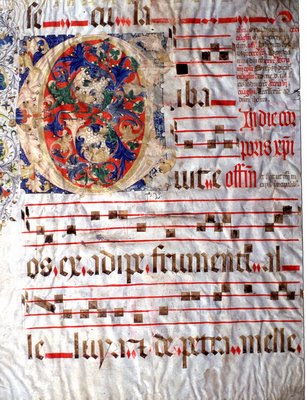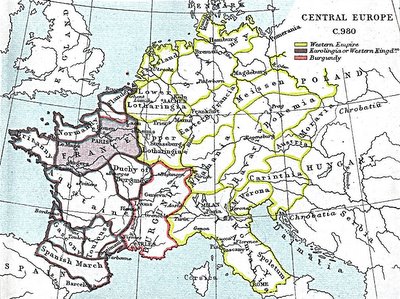Monday, October 02, 2006
Thursday, September 14, 2006
Friday, September 08, 2006
St. Alphege Captured
Alphege (or Elphege or Aelfheah), Archbishop of Canterbury, was captured by marauding Danes, held prisoner for months, and eventually murdered. He refused to allow himself to be ransomed because the money would have had to be raised by taxing the people. After his death he was venerated as a martyr, and the parish church of Greenwich is dedicated to him.
Tuesday, August 15, 2006
Wednesday, June 14, 2006
Wednesday, June 07, 2006
Thursday, May 04, 2006
Friday, March 24, 2006
The vessel could date to the mid-1500s, when the first Spanish settlement in what is now the United States was founded here, the archaeologists said.
But the exposed portion looks more like ships from a later period because of its iron bolts, said Elizabeth Benchley, director of the Archaeology Institute at the University of West Florida.
"There are Spanish shipwrecks in Pensacola Bay," Benchley said. "We have worked on two - one from 1559 and another from 1705. But no one has found one buried on land. This was quite a surprise to everybody."
The exposed keel of the ship juts upward from the sandy bottom of the pit and gives some guess of the vessel's form. Archaeologists estimated the rest of the ship is buried by about 75 feet of sand.
During initial work to determine the ship's origin, archaeologists found ceramic tiles, ropes and pieces of olive jars. The settlement was founded in 1559; its exact location is a mystery. The Spanish did not return until more than a century later in 1698 at Presidio Santa Maria de Galve, now the naval station.
The French captured and burned the settlement in 1719 but handed Pensacola back to Spain three years later. Hurricanes forced the Spanish to repeatedly rebuild.
The Navy plans to enclose the uncovered portion of the ship, mark the site and move construction over to accommodate archaeological work, officials said.
"We don't have plans to excavate the entire ship," Benchley said. "It's going to be very expensive because it's so deeply buried and we would have to have grant money," she said.
Friday, March 03, 2006
Archeologists have found a shipwreck from the late 1300s buried in the mud of a bay in central Stockholm, officials said Thursday. They are now awaiting permission to excavate the wreckage - one of the oldest ever found in the Swedish capital - hoping it will shed light on shipbuilding techniques and trade in the 14th century.
Experts say they might be able to bring the ship up on land, as was done with the 17th century warship Vasa, which is now housed in a museum that is one of Stockholm's main tourist attractions.
Parts of the wreckage are protruding from the brackish sediment at a depth of about 30 feet in the Riddarfjarden bay leading into the heart of Stockholm, National Maritime Museum officials said.
Archeologists found it last year when examining the planned site for a new train tunnel. They have now dated the ship to between 1350 and 1370, and believe it sank sometime in the 1390s.
"This is really exciting," said Marcus Hjulhammar, project leader for the museum.
"What is so special is that it is under water, here in Stockholm," he said. "That makes it much more likely that it is well-preserved than if it had been on land."
Shipwrecks have a decent chance of being well-preserved in the low-salt waters of the Stockholm archipelago because of the lack of wood-eating shipworms.
If the entire ship - the size and type of which are unclear - is still intact, its cargo could give historians a better idea of trading that took place in the area at the time.
There is a large crack in the hull, which had been covered by a piece of leather that had been nailed to the boards, Hjulhammar said.
"That is a sign that this ship was very worn down, and it is possible that this repair work is part of the reason it sank," he said. "My spontaneous reaction was that the repair was rather clumsily done."
The museum is awaiting permission from the county government to dig out the remaining parts of the ship, Hjulhammar said. They would then decide whether it is possible to bring it up on land.
"But it depends on how eroded it is," he said. "It may turn out that it is better to let her lie."
---
Wednesday, February 22, 2006
Tuesday, February 14, 2006
The woman warrior-turned-saint remains omnipresent in the French imagination, nearly 600 years after her ashes were thought to have been thrown into the Seine River.
A few remains were reportedly recovered from the pyre where the 19-year-old was burned alive. A team of 18 experts now plans a battery of tests to determine whether the remains — including a rib bone and some skin — indeed belonged to her.
http://www.msnbc.msn.com/id/11330320
Friday, February 03, 2006
These wood carvings were removed when the church was restored at the end of the 19th century. They probably formed part of the roof decoration, the largest almost certainly being a roof boss. The predominant decorative theme is clearly leafy and floral. The finest piece shows the 'Green Man' or ('Jack in the street'). Originally this was probably the personification of the spirit in the pagan tree-symbol. The Church adopted it and it became a common theme in ecclesiastical carving.

Thursday, January 26, 2006
I enjoy leatherwork and I think I am about to start work on one of these for myself.

Flask, leather, late medieval"Flask, leather, the body and base formed of two pieces of leather. D-shaped long- and cross-section, oval in outline. The base, slightly concave, is a continuation of the flattened half. The halves are stitched with waxed cord forming an outward facing seam down each side and around the edge of half the base. The seams are externally lined with pitch. Two leather loops, 3-4cm long, are set into slots in the seam on each side, one on the shoulder and one 3.5cm above the base. The body tapers in a short neck to the mouth, which is near- rectangular with rounded corners, and slightly puckered 2-2.5cm below the rim, showing the marks of the now missing lid. There are small incomplete perforations on three corners immediately above the pucker, and a small dent below the rim on one side with wear above it to the rim, possibly indicating a hinged lid.
Late medieval C15th C16th FRNO 547 548 549 H. 35.3; W. max 21.2; D. base 14.4 x 12.0; D. rim ext 4.6 x 3.6, T wall 0.4; Wt. 686.2gDatePeriod: MedievalEarly: 1400Late: 1600Century: 15 16
Friday, January 20, 2006

I found this info on an auction site.
A good English three-quarter Armour composite, C. 1580 - 1610.
BURGONET with two piece skull and high comb, hinged ear guards, riveted peak and neck guard, main borders rolled, "#13" stamped on right ear guard, still retaining it's original burlap liner, (very rare).
Breastplate well formed, and painted "no 15" inside, with strong central ridge, heavy rolled neck and arm cusps, one plate fauld with attached tassets of five lames.
Backplate with rolled and roped edges and armoures mark of four dots, one in each corner.
Arm defenses comprising pauldrons of three lames with rolled and roped edges upper and lower cannons and elbow cops, finger gauntlets with high cuff and five metacarpal lames, fingers and thumb. Gorget front and rear each with three-neck plates rolled and roped edges. Some repair, restoration and replacements.
Breast plate and Helmet deaccessioned from Tower of London, 1972, mounted on a plastic mannequin with a foam head on a turned Mahogany Wooden base.
SOLD $ 17,500 US
Thursday, January 19, 2006

Well, I have been slow to update but now hopefully I will be able to start doing it a little more regularly. I am not sure that I like blogging as a way of actually providing useful information that should be in a more static form. For example, there is no way that I can find to put all of the photos in one folder and have them available for view without a person having to search the enitire blog. I may just make my own website instead of continuing to blog this info. Don't get me wrong, I think that blogging is a good way to keep updated with ever changing information and would be useful for a news site or personal journal. Anyway, here is today's new post.
February from the Book of Hours 1490


